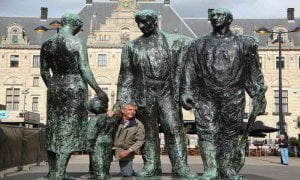Tourist Circuit of India : India’s rich culture, tradition, heritage, life values and natural setup starting from Himalaya to Indian Ocean can be seen as individual attraction as well as when we connect more than two destinations having similar or dissimilar background but same location may complement each other in form of tourist circuits. This chapter will highlights some of the most popular tourist circuits in India as well as few upcoming one.
6. Desert Delight (Jodhpur-Jaisalmer-Bikaner)
Rajasthan the Northern-west desert state of India is best known for its vibrant culture, colorful handicrafts, royal palaces, magnificent forts, joyful people and amazing sand dunes. This circuit provides the best opportunity of experience all these attractions and most notably the sun and sand in a single trip.
Jodhpur: this former capital of the state of Marwar was founded in 15th century by the Rathore Rajputs. The major attraction of the city is breathtaking, magnificent Mehrangarh fort. It appears to rise from bluff-coloured sandstone hill itself. There are other grand testimonials of glorious past of the city like Umaid Bhavan Palace and Jaswant Thada. Others attractions are Mandor garden, Sardar Bazar, Taleti Mahal, and local market famous for leather products.
Jaisalamer: Situated in Thar Desert, founded in the 12th century by Maharawal Jaisal of Bhatti Rajput clan. The building here are made by local golden-yellow sandstone which gave the city name ‘golden city’. The main attraction of city is Jaisalmer Fort and havelis of rich businessman. Salim Singh’s haveli, Nathmalji’s haveli, Patwon ki haveli are having more intricate stone carving and jali work. Gadsisar Lake, Manak Chowk, Gyan Bhandar, Jain Temple, Khuri Sand Dunes and Gadi Sagar are other attractions of Jaisalmer. Camel safari in sand dunes is most popular among tourist.
Bikaner: Bordering the Thar desert, this is one of the earliest established cities of Rajasthan. It was found in 1486 by Rao Bika, younger son of Rao Jodha of Jodhpur. The most distinguished attraction of the city is Majestic and spellbinding Junagarh Fort and Palaces. It is also well known for its Karni Mata temple where rats are fed milk hence famous by rat temple. Other attractions of the city are Lalgarh Palace, Walled city,
Kothari’s haveli, Camel breeding farm, and desert festival.
7. Heritage circuit (Bijapur-Badami-Pattadakal-Hampi)
Karnataka state being the center of few of the most powerful dynasties of South India is packed with abundant marvelous heritage sites. These three most visited heritage cities reflects the rich history, art, architecture and affluence of Southern India in the form of World Heritage monuments, forts and palaces, historic sites, temples and ruins.
Bijapur: It was founded by Adil Shah who emerged as the principal rular of Deccan in the 16th and 17th Century. Gol Gumbad is Bijaupr’s most celebrated building which is monumental tomb of Mohammad Adil Shah (1627-56). The Citadel, Jami Masjid, Asar Mahal, Ibrahim Rauza are other attractions of Bijapur.
Badami: Situated within horseshoe of a red sandstone cliffs, once this was historic capital of early Chalukya kings who ruled the Deccan during 6th-7th cen AD. Among the rock-cut and structural monuments, the most richly decorated are the cave temples. Cave 1 is dedicated to Shiva, Cave 2 & 3 to Vishnu and Cave 4 is dedicated to Jain saints. Yellamma Temple, Jambulinga Temple, Bhutanath temple, Archaeological museum are other attractions of Badami.
Pattadakal: Pattadakal is a town close to Badami. It is renowned for the group of monuments and temple of Hindu and Jain religion and granted the World Heritage status by UNESCO for the exceptional example of art and architecture. Two styles of temple exists in Pattadakal- North India-style (Kadasiddeshvara, Jambulinga, Galaganatha, and Kashi Vishvanath temple) and South Indian-style (Sangameshvara, Virupaksha, Mallikarjuna and Papanatha Temple). The Mallikarjuna and Virupaksha temple both dedicated to Shiva having large sculptures on pillars.
Hampi: A UNESCO World Heritage site on the south bank of Tungabhadra river, Hampi holds the ruins of Vijayanagar. Hampi was capital of three generations of Hindu rulars for more than 200 years. The site comprises of Sacred and Royal centres with rocky ridges and granite boulders acting as natural defences. Krishna Temple (Krishnadeva Raya erected in 1516), Virupaksha Temple (dedicated to goddess Pampa), Narsimha
Monolith, King’s balance, Lotus temple, Stepped Tank and Vitthala Temple are major attractions of Hampi.
8. Shimla-Kullu-Manali-Dharmashala
Himachal, “the adobe of snow” covers over 56,000sq km of the Western Himalaya. The state terrain rises from foothills of Shivalik bordering the plains of Punjab and extends to the trans-Himalayan heights of the Zanskar Range. Shimla, the capital of Himachal Pradesh was once famous summer capital of the British Raj, is still most popular destination.
Shimla: it is the capital state of Himachal Pradesh. Once the summer capital of British India, this beautiful mountain city still remains the highly demanding the most favorite choice of tourists. The attractions of Shimla are quite diverse and wide including natural, religious, artistic and historic attractions. Major sites to visit are, the Mall, Observatory Hill, Arki Fort, Gaiety Heritag, Himachal State Museum, Jakhu Temple, Christ Church, Scandal point and wooden market.
Kullu: The Kullu, in the ancient Sanskrit text referred as “Kulantapith” and locally known as “valley of the Gods” is watered by Beas river. Its alpine setting is gathering of 360 gods from different temples. The chief attraction of Kullu is 17th century Raghunath Temple dedicated to Rama and Sita.
Manali: Manali is one of the most popular and highest visited hill stations in the world. Nature has blessed this place with such stunning attractions that draw the visitors from all corners of the country. It is the best spot for all kind of adventure activities like whitewater rafting, trekking, mountaineering and snow-skiing. Major sites to visit are Kothi valley, Solang valley, Rohtang pass and Rohtang waterfall.
Dharmshala: This hill station established by British, is today more famous because of home of Dalai Lama. Located on the lower spurs of Dhauladhar range, the town consists of two sections-lower town with main bus stand and bazaar and upper town known as McLeodganj. Upper town is primarily Tibetan settlement with its focal point Tsunglagkhang complex (residence of Dalai Lama). Namgyal Monastery, Tibetan Institute of Performing Arts, Nechung Monastery and several Tibetan gompas are major attraction.
9. Chardham Yatra (Yamunotri-Gangotri-Kedarnath-Badrinath)
Chardham Yatra is one of the most accessible and sacred Hindu pilgrimage yatra of India, begins every year in April-May and continues till Oct-Nov in Uttarakhand. Sitting amidst the mighty and high Himalayan ranges all these spots are surrounded with breathtaking, pristine natural surroundings and reached by trekking routes only.
Yamunotri: It is the traditionally first destination of Chardham yatra. The picturesque journey along with River Yamuna with a view of Rawaai Ghaati. The main deity is Goddess Yamuna, represented in black marble idol. The other deity in white marble is Goddess Ganga. Just outside the main temple is the Divya Shila from which springs thermal Sulphur springs. Almost 7 km away at Jankichatti the other sacred sites are Saptarishi kund and Surya Kund.
Gangotri: The Gangotri shrine overlooks the thundering River Bhagirathi, is that the spiritual source of India’s holiest river, the Ganga. Hindu perform the ancestral rites of shradha and pind dan for ancestors here. The actual source of river is the ice cave of Gomukh. The temple at Gangotri is believed to be consecrated by Adi Shankracharya in 18th century. Nearby is that the Bhagirath Shila, a stone slab where king Bhagirath meditated. A special shringar puja is performed on ganga Saptami, Ganga Dussehara and Yam Dwitiya.
Kedarnath: The trek for Kedarnath (3584 mts) begins from Gaurikund. (3584 mts) where Goddess Parvathi believed to meditated to attain Lord Shiva. The Kedarnath shrine is the northernmost Jyotirlinga and third stop at this yatra which is very close to river Mandakini. Kedarnath is also part of Panch Kedar yatra. Pilgrims generally take a bath at the hot spring in Gaurikund before proceeding for Kedarnath.
Badrinath: Badrinath Temple devoted to Lord Vishnu situated against the backdrop of the Neelkanth Peak, by the river Alakhnand at an altitude of 3,133 m (10,276 feet). The presiding deity may be a meditating Lord Vishnu in black stone. A group of idol I the temple which include Ganesh, Laxmi, Nar-Narayan, Kuner and Narad installed here. Nearby Badrinath is Joshimath (48 km) is seat of Adi Shankaracharya.
10. Jain Pilgrimage Circuit (Pawapuri-Mt. Abu-Junagarh-Palitana Shrawanbelagola)
Jainism flourished in Gujarat under the Solanki ruler of Patan, Kumarpal (1143–1172 AD) under the tutelage of Jain Acharya Hemachandra. Adinath. Now it is the hub of Jain pilgrimage centers with some of the most sacred and ancient sites associated with Jainism.
Pawapuri: Mahavira, the last i.e 24th, tirthankar and founder of Jainism, died and cremated here at Pawapuri. A white marble daigambar temple known as Jalmandir was build in memory of this event. A special ritual and prayers were organized on the day of Diwali and Chaturmas.
Palitana: The Palitana temples complex are considered the most sacred Jain pilgrimage center. There are quite 1300 temples located atop the Shatrunjaya Hill, exquisitely carved in marble. These temples are built by generations of Jains over a period of 900 years from 11th century onwards. The main temple on top of Capitol Hill , is devoted to 1st tirthankar lord Adinath (Rishabdeva). There are incredibly more than 27000 idols in the complex.
Junagarh: Junagarh and The hill of Girnar (near Junagarh) are equally sacred as the 22nd tirthankara Neminatha attained moksha here. His idol, considered among the oldest within the world, predates the development of the temple in 12th century. Junagadh is significant Hindu and Jain pilgrim center being home of several holy temples. Some of the notable holy sites include shrines of Neminath, Mallinath, Parshvanath, the golden shrine of Rishabhadev, Bhavnath Mahadev Temple – The famous Bhavnath Fair takes place every year at this temple site, which attracts millions of pilgrims from all over the country, Amba Mata Temple, Temple of Gorakhnath.
Shrawanbelagola: This place is included in one of the most important and oldest Jain pilgrimage centres in India. It is the site of huge 17 m high statue of Gomateshwar (Bahubali), a Jain deity. Sravanbelagola has long back history going back to the 3rd century BC.





